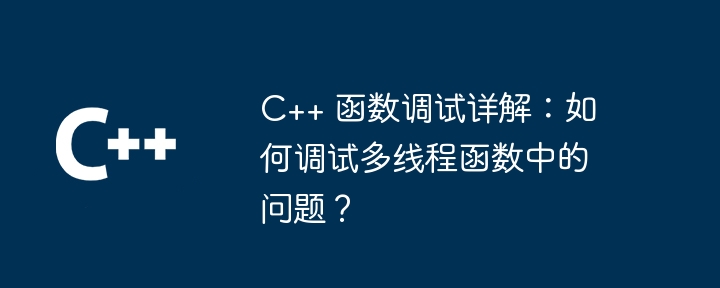C++ 函式偵錯詳解:如何偵錯多執行緒函數中的問題?
C 多執行緒偵錯可使用GDB:1. 啟用偵錯資訊編譯;2. 設定斷點;3. 使用info threads 檢視執行緒;4. 用thread <n> 切換執行緒;5. 使用next、stepi、 locals 調試。實戰案例調試死鎖:1. 使用 thread apply all bt 列印堆疊;2. 檢查執行緒狀態;3.單步執行主執行緒;4. 使用條件變數協調存取來解決死鎖。

C 函數偵錯詳解:如何偵錯多執行緒函數中的問題?
引言
多執行緒程式設計可以顯著提高應用程式的效能,但它也帶來了更複雜的偵錯過程。本文將深入探討如何在 C 中除錯多執行緒函數,並提供一個實戰案例來展示除錯技術。
使用 GDB 偵錯多執行緒
GDB(GNU 偵錯器)是一個強大的工具,可用來偵錯 C 多執行緒程式碼。若要使用 GDB 偵錯多執行緒函數,請執行下列步驟:
- 編譯程式碼時啟用偵錯資訊(例如:
g -gmulti ...)。 - 在 GDB 中設定斷點(例如:
break main)。 - 執行程式並在所需位置停止(例如:
run args)。 - 使用
info threads指令查看執行緒清單。 - 使用
thread <n>指令切換到特定的執行緒。 - 使用其他GDB 指令進行偵錯,例如
next、stepi和locals,分別用於單步執行、逐行執行和檢查局部變數。
實戰案例:除錯一個死鎖多執行緒函數
以下是偵錯一個死鎖多執行緒函數的實戰案例:
#include <iostream>
#include <thread>
#include <mutex>
std::mutex mutex;
void thread_func() {
while (true) {
std::lock_guard<std::mutex> guard(mutex);
std::cout << "Thread is holding the lock" << std::endl;
std::this_thread::sleep_for(std::chrono::seconds(1));
}
}
int main() {
std::thread t(thread_func); // Start the thread
std::lock_guard<std::mutex> guard(mutex); // Attempt to acquire the lock in main
std::cout << "Main thread is waiting for the lock" << std::endl;
t.join(); // Wait for the thread to finish
}偵錯過程
在GDB 中偵錯此函數時,我們發現它死鎖了,因為主執行緒嘗試取得由另一個執行緒持有的鎖。要解決此問題,我們可以執行以下步驟:
- 使用
thread apply all bt命令在所有執行緒中列印呼叫堆疊。 - 觀察到主執行緒和另一個執行緒都在等待相同的鎖。
- 使用
thread info <n>指令檢查另一個執行緒的狀態,發現它正在休眠。 - 使用
next命令單步執行主線程,發現它無法獲得鎖,因此死鎖。
解決方法
要解決此死鎖,我們可以使用條件變數來協調執行緒之間的存取。以下是一個修改後的程式碼片段:
#include <iostream>
#include <thread>
#include <mutex>
#include <condition_variable>
std::mutex mutex;
std::condition_variable cv;
void thread_func() {
while (true) {
std::unique_lock<std::mutex> guard(mutex);
cv.wait(guard); // Wait for the condition variable to be notified
std::cout << "Thread is holding the lock" << std::endl;
std::this_thread::sleep_for(std::chrono::seconds(1));
}
}
int main() {
std::thread t(thread_func); // Start the thread
std::unique_lock<std::mutex> guard(mutex);
cv.notify_all(); // Notify the other thread to acquire the lock
guard.unlock(); // Release the lock in main
t.join(); // Wait for the thread to finish
}以上是C++ 函式偵錯詳解:如何偵錯多執行緒函數中的問題?的詳細內容。更多資訊請關注PHP中文網其他相關文章!

熱AI工具

Undresser.AI Undress
人工智慧驅動的應用程序,用於創建逼真的裸體照片

AI Clothes Remover
用於從照片中去除衣服的線上人工智慧工具。

Undress AI Tool
免費脫衣圖片

Clothoff.io
AI脫衣器

Video Face Swap
使用我們完全免費的人工智慧換臉工具,輕鬆在任何影片中換臉!

熱門文章

熱工具

記事本++7.3.1
好用且免費的程式碼編輯器

SublimeText3漢化版
中文版,非常好用

禪工作室 13.0.1
強大的PHP整合開發環境

Dreamweaver CS6
視覺化網頁開發工具

SublimeText3 Mac版
神級程式碼編輯軟體(SublimeText3)
 C#與C:歷史,進化和未來前景
Apr 19, 2025 am 12:07 AM
C#與C:歷史,進化和未來前景
Apr 19, 2025 am 12:07 AM
C#和C 的歷史與演變各有特色,未來前景也不同。 1.C 由BjarneStroustrup在1983年發明,旨在將面向對象編程引入C語言,其演變歷程包括多次標準化,如C 11引入auto關鍵字和lambda表達式,C 20引入概念和協程,未來將專注於性能和系統級編程。 2.C#由微軟在2000年發布,結合C 和Java的優點,其演變注重簡潔性和生產力,如C#2.0引入泛型,C#5.0引入異步編程,未來將專注於開發者的生產力和雲計算。
 Golang和C:並發與原始速度
Apr 21, 2025 am 12:16 AM
Golang和C:並發與原始速度
Apr 21, 2025 am 12:16 AM
Golang在並發性上優於C ,而C 在原始速度上優於Golang。 1)Golang通過goroutine和channel實現高效並發,適合處理大量並發任務。 2)C 通過編譯器優化和標準庫,提供接近硬件的高性能,適合需要極致優化的應用。
 vscode在哪寫代碼
Apr 15, 2025 pm 09:54 PM
vscode在哪寫代碼
Apr 15, 2025 pm 09:54 PM
在 Visual Studio Code(VSCode)中編寫代碼簡單易行,只需安裝 VSCode、創建項目、選擇語言、創建文件、編寫代碼、保存並運行即可。 VSCode 的優點包括跨平台、免費開源、強大功能、擴展豐富,以及輕量快速。
 表演競賽:Golang vs.C
Apr 16, 2025 am 12:07 AM
表演競賽:Golang vs.C
Apr 16, 2025 am 12:07 AM
Golang和C 在性能競賽中的表現各有優勢:1)Golang適合高並發和快速開發,2)C 提供更高性能和細粒度控制。選擇應基於項目需求和團隊技術棧。
 Golang和C:性能的權衡
Apr 17, 2025 am 12:18 AM
Golang和C:性能的權衡
Apr 17, 2025 am 12:18 AM
Golang和C 在性能上的差異主要體現在內存管理、編譯優化和運行時效率等方面。 1)Golang的垃圾回收機制方便但可能影響性能,2)C 的手動內存管理和編譯器優化在遞歸計算中表現更為高效。
 Python與C:學習曲線和易用性
Apr 19, 2025 am 12:20 AM
Python與C:學習曲線和易用性
Apr 19, 2025 am 12:20 AM
Python更易學且易用,C 則更強大但複雜。 1.Python語法簡潔,適合初學者,動態類型和自動內存管理使其易用,但可能導致運行時錯誤。 2.C 提供低級控制和高級特性,適合高性能應用,但學習門檻高,需手動管理內存和類型安全。
 在 visual studio code 中使用 c 嗎
Apr 15, 2025 pm 08:03 PM
在 visual studio code 中使用 c 嗎
Apr 15, 2025 pm 08:03 PM
在 VS Code 中編寫 C 語言不僅可行,而且高效優雅。關鍵在於安裝優秀的 C/C 擴展,它提供代碼補全、語法高亮和調試等功能。 VS Code 的調試功能可幫助你快速定位 bug,而 printf 輸出是老式但有效的調試方法。此外,動態內存分配時應檢查返回值並釋放內存以防止內存洩漏,調試這些問題在 VS Code 中很方便。雖然 VS Code 無法直接幫助進行性能優化,但它提供了一個良好的開發環境,便於分析代碼性能。良好的編程習慣、可讀性和可維護性也至關重要。總之,VS Code 是一
 VSCode怎麼用
Apr 15, 2025 pm 11:21 PM
VSCode怎麼用
Apr 15, 2025 pm 11:21 PM
Visual Studio Code (VSCode) 是一款跨平台、開源且免費的代碼編輯器,由微軟開發。它以輕量、可擴展性和對眾多編程語言的支持而著稱。要安裝 VSCode,請訪問官方網站下載並運行安裝程序。使用 VSCode 時,可以創建新項目、編輯代碼、調試代碼、導航項目、擴展 VSCode 和管理設置。 VSCode 適用於 Windows、macOS 和 Linux,支持多種編程語言,並通過 Marketplace 提供各種擴展。它的優勢包括輕量、可擴展性、廣泛的語言支持、豐富的功能和版






